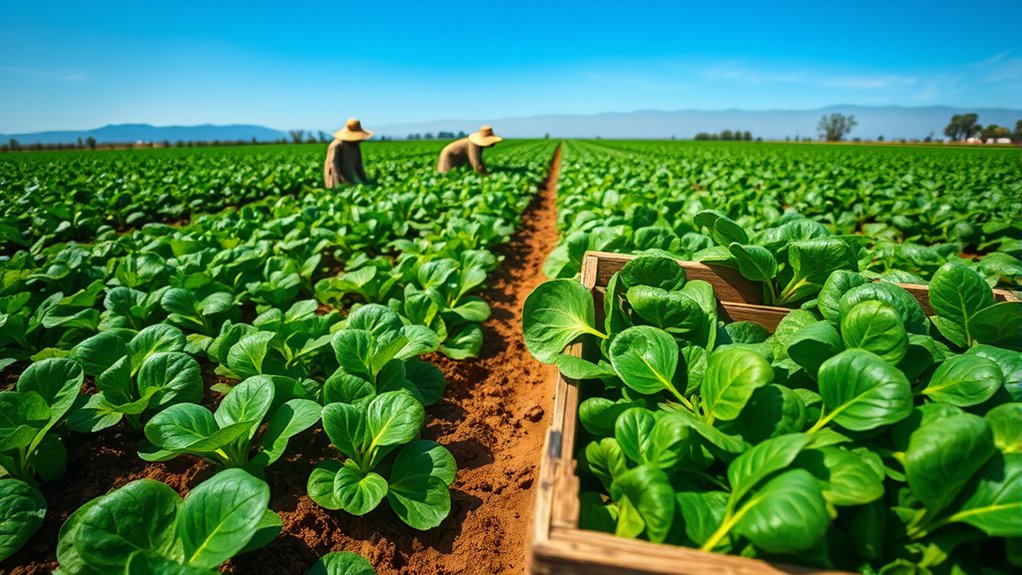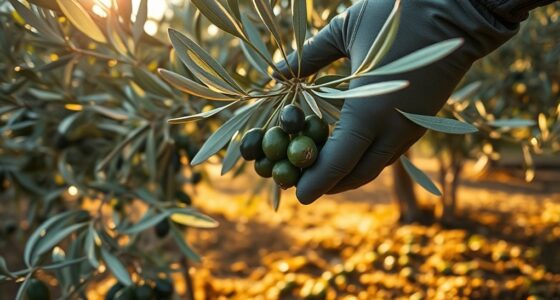To keep spinach fresh, harvest in the morning or evening, targeting plants that are 4-6 inches tall. Cool immediately with hydrocooling or forced-air cooling, maintaining optimal humidity during storage at 32°F. Use clean, sharp tools for harvesting and sort out damaged leaves. Keep the cold chain intact during transport, ensuring temperatures stay between 32-36°F. For even better strategies and insights, there's more you can discover about maintaining spinach freshness.
Key Takeaways
- Harvest spinach in the morning or evening to reduce heat stress and maintain freshness.
- Use hydrocooling or forced-air cooling methods immediately after harvest to remove field heat.
- Store spinach at 32°F with 95-100% humidity in perforated plastic bags for optimal freshness.
- Sort and clean leaves before packing, removing damaged ones to prevent spoilage during storage.
- Maintain a consistent cold chain during transport, ensuring temperatures are between 32–36°F and humidity is 90–98%.
Optimal Harvesting Techniques

To keep your spinach fresh and flavorful, timing and technique are crucial. Harvest your spinach in the morning or evening to prevent heat stress. Aim for plants that are 4-6 inches tall and have multiple leaves, ideally before the weather warms up to avoid bolting.
For baby spinach, pick leaves while they're still tender and sweet. Use scissors for small quantities, or a serrated knife for bulk harvests, cutting above the crown to encourage regrowth.
Start with the outer, older leaves and move toward the center, avoiding any yellow or wilted ones. Remember, harvesting promptly prevents bolting and maintains flavor, ensuring your spinach stays fresh longer.
Effective Cooling and Storage Methods
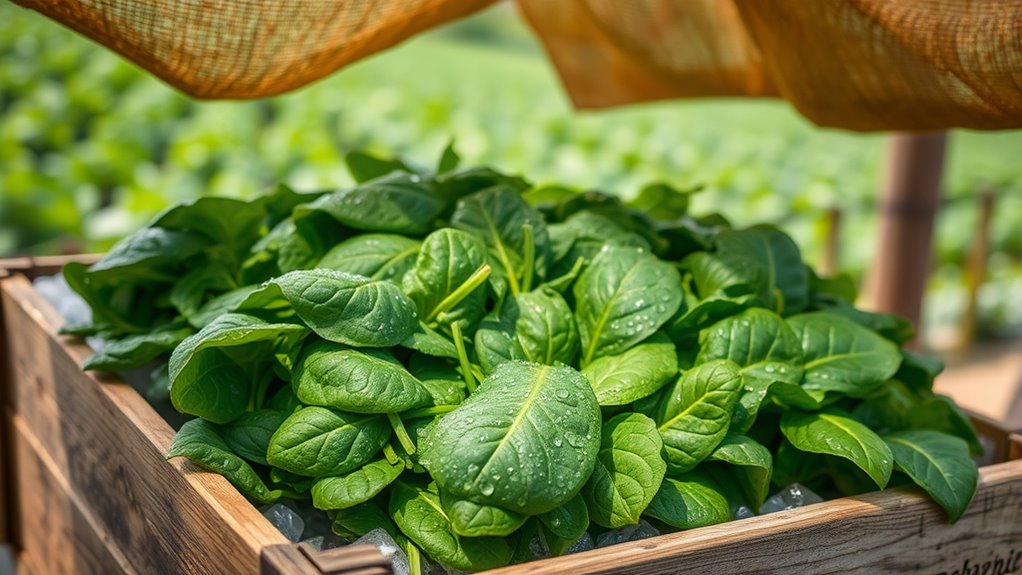
After harvesting your spinach, the next steps in keeping it fresh involve effective cooling and storage methods.
Start by hydrocooling, rapidly submerging the spinach in near-freezing water to remove field heat. Alternatively, consider forced-air cooling to circulate cold air while maintaining humidity. Vacuum cooling is effective for wet spinach, while top ice cooling provides quick freshness.
Store spinach at around 32°F (0°C) with a humidity level of 95% to 100%. Use perforated plastic bags for storage, ensuring adequate ventilation to prevent spoilage.
Avoid excess moisture by not washing before storage. Regularly inspect for spoilage and use absorbent materials in containers to manage moisture.
These methods can help extend the shelf life of your spinach effectively.
Proper Handling and Packing Procedures

When you handle and pack spinach, maintaining its freshness is crucial for quality and shelf life. Start by harvesting young, tender leaves with sharp knives to minimize damage. Regularly check for signs of bolting, especially in warmer weather.
After harvesting, control moisture by drying the spinach thoroughly to prevent spoilage. Sort and clean the leaves, removing any damaged ones. Prepare your packaging materials—make sure they're clean and dry.
Pre-cool the spinach to slow respiration rates. Use modified atmosphere packaging for optimal freshness and manage in-pack weight for gas exchange.
Finally, maintain consistent refrigeration during transport and keep humidity high to preserve quality. Regularly inspect for spoilage during handling to ensure you deliver the best product.
Importance of Sanitation and Hygiene
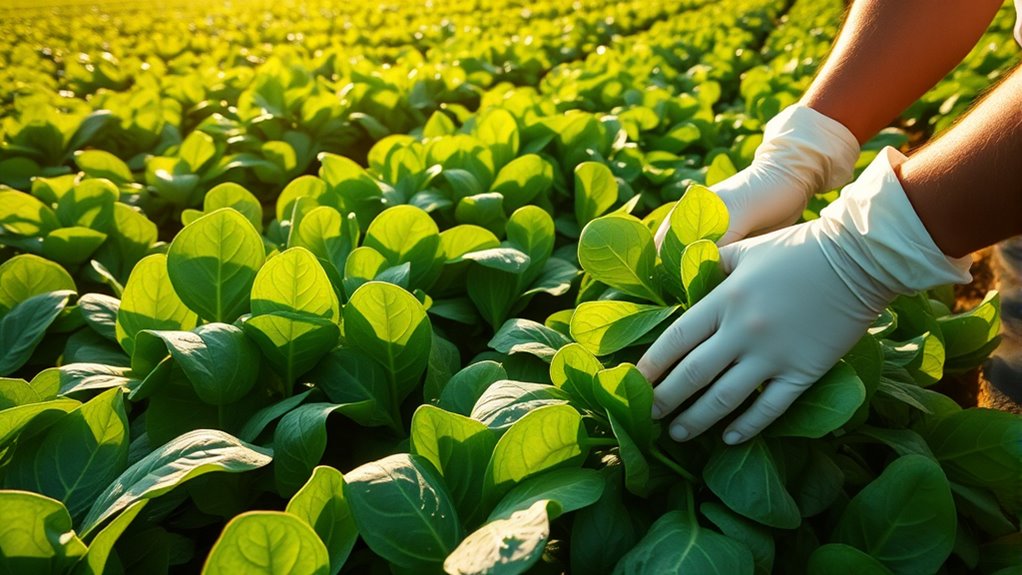
Maintaining freshness in spinach goes hand-in-hand with rigorous sanitation and hygiene practices on the farm. Clean water for irrigation is essential; it should be free of contaminants to protect your crop.
Implement soil management techniques, like crop rotation, to minimize soil-borne pathogens. Regularly clean and sanitize your equipment to reduce contamination risks.
Training field workers on hygiene—such as using portable toilets and handwashing stations—is crucial. Provide clean sanitation facilities to enhance overall hygiene.
Monitor fields for signs of animal intrusion and use gloves to limit direct contact with your produce. With these practices, you can significantly decrease the chances of contamination, ensuring your spinach remains fresh and safe for consumption.
Efficient Transportation and Logistics Strategies
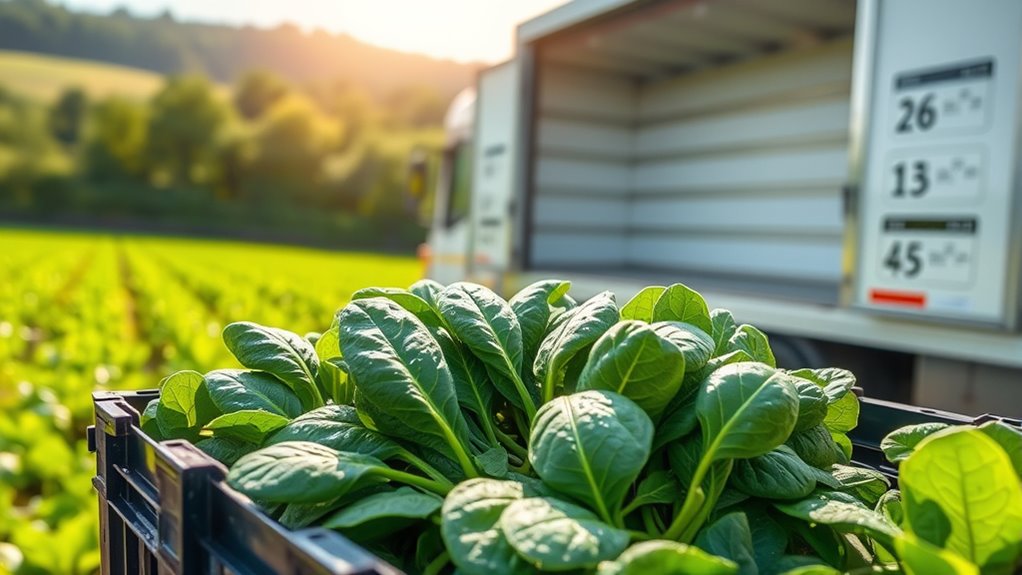
To keep spinach fresh from farm to table, efficient transportation and logistics strategies are essential.
Start by maintaining optimal temperatures between 32–36°F (0–2°C) and humidity levels of 90–98% to prolong freshness. Use breathable, moisture-resistant packaging to prevent spoilage during transit.
Implement real-time tracking to quickly address any issues and optimize routes to reduce transit times. Maintain an uninterrupted cold chain and comply with regulations like the FDA's Food Safety Modernization Act.
Collaborate with carriers to ensure they understand the specific needs of fresh produce. Regularly sanitize vehicles, maintain refrigeration units, and train drivers in handling perishables.
Gentle handling and proper stacking during loading further protect the spinach's quality throughout transportation.
Frequently Asked Questions
What Are the Signs of Spinach Maturity for Harvesting?
You'll know spinach is ready for harvest when you see a rosette of five or six leaves, and the plants reach 4-6 inches tall.
Look for leaves that are the right size for your needs; baby leaves are great for salads, while larger ones work well for cooking.
If a stem shoots up from the foliage, that's a sign of bolting—harvest immediately to maintain quality.
Timing is crucial for the best flavor and texture.
How Can I Identify Damaged Spinach Leaves?
Did you know that about 30% of spinach can be rejected due to visible damage?
To identify damaged spinach leaves, look for small tunnels or brown blotches from leaf miners, and check for crushed or broken leaves from rough handling.
Discoloration, such as yellow or black spots, signals potential issues.
Also, keep an eye out for dirt and debris, as clean leaves are essential for quality.
Inspecting carefully ensures you select the best spinach.
What Is the Ideal Humidity Level for Spinach Storage?
The ideal humidity level for storing spinach is between 95% and 100%.
This high humidity prevents the leaves from drying out and maintains their freshness.
When you store spinach, make sure the environment is humid enough to avoid desiccation, which can ruin its quality.
Keeping the humidity at this level, along with a temperature of around 0°C (32°F), will help extend the shelf life of your spinach significantly.
How Often Should Sanitation Practices Be Reviewed?
Imagine a well-tended garden, where each flower represents a crucial aspect of sanitation.
You should review your sanitation practices at least annually, like checking the soil for nutrients. Regular assessments help you spot areas needing improvement.
If regulations change or new equipment arrives, don't wait—review immediately. Frequent checks ensure everyone stays informed and keep standards high, protecting both your product and your reputation.
Consistent evaluations pave the way for continuous growth and excellence.
What Are the Best Practices for Freezing Spinach?
To freeze spinach effectively, start by washing and drying the leaves thoroughly.
Sort out any damaged ones, then choose whether to blanch for better nutrient retention. You can freeze spinach directly for smoothies or blanch before freezing.
Portion it into recipe-specific amounts, using freezer-safe bags or containers.
Make sure to label them with the date and remove as much air as possible to prevent freezer burn.
Enjoy your frozen spinach for up to six months!
Conclusion
By mastering these best practices, you're not just preserving spinach; you're nurturing a vibrant green tapestry that bursts with life and flavor. Each leaf you handle, cool, and transport becomes a promise of freshness, like a dewdrop glistening in the morning sun. Remember, your care transforms simple greens into a nourishing gift, ready to grace tables and nourish families. So, embrace these techniques, and let your spinach shine like emeralds in a farmer's market.

